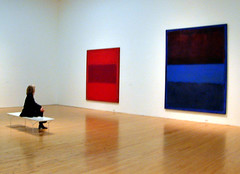Mark Rothko, born Marcus Rothkowitz (Latvian: Marks Rotko; September 25, 1903–February 25, 1970), was a Latvian-born American painter and printmaker, says Wikipedia. He is classified as an abstract expressionist, although he rejected not only the label but even being called an abstract painter.
During the Depression Rothko found employment, as did many other artists, with the Works Progress Administration, a labor relief agency created under Roosevelt’s New Deal in response to the economic crisis. As the Depression waned, Rothko continued on in government service, working for TRAP, an agency that employed artists, architects and laborers in the restoration and renovation of public buildings. Avery, DeKooning, Pollock, Reinhardt, David Smith, Louise Nevelson, and Rothko’s old teacher, Arshile Gorky, were also employed by TRAP.
In 1936, Rothko began writing a book, never completed, about the similarities in the art of children and the work of modern painters. The work of modernists, influenced by primitive art, could be compared to that of children in that "child art," according to Rothko, "transforms itself into primitivism, which is only the child producing a mimicry of himself." In this same manuscript, he observed that "the fact that one usually begins with drawing is already academic. We start with color."
The "Abstract Expressionist" movement was a loose consortium of mostly secular, urban Jews including Rothko and two other artists he was associated with, Gottlieb and Newman. Self-perceived outsiders and intellectuals, they viewed the freedom afforded by Modernism with no small degree of suspicion, interpreting this freedom as a source of suffering as opposed to release.
In 1961 a retrospective of his work was held at the Museum of Modern Art, to considerable commercial and critical success. In spite of this newfound notoriety, the art world had turned its attention from the now passé abstract expressionists to the "next big thing", Pop Art, particularly the work of Warhol, Lichtenstein, and Rosenquist.
The most exciting chapter of his life in art was the six-year period in which he prepared paintings for the Menil family in Houston.
The Rothko Chapel is located adjacent to the Menil Collection and The University of St. Thomas in Houston, Texas. The building is small, windowless, and unassuming. It is a decidedly geometric, postmodern structure, located in a turn of the century middle-class Houston neighborhood. The Chapel, the Menil Collection, and the nearby Cy Twombly gallery were funded by Texas oil millionaires John and Dominique de Menil.
Rothko never saw the completed Chapel and never installed the giant paintings. On February 28, 1971, at the dedication, Dominique De Menil said of the paintings: "We are cluttered with images and only abstract art can bring us to the threshold of the divine", noting Rothko’s courage in painting these impenetrable fortresses of color. The drama for many critics of Rothko’s work is the uneasy position of the paintings between, as Chase notes, "nothingness or vapidity" and "dignified ‘mute icons’ offering ‘the only kind of beauty we find acceptable today’."
In the spring of 1968, Rothko suffered an aneurysm of the aorta, a result of his chronic high blood pressure. Ignoring doctor’s orders, Rothko continued to drink and smoke heavily, avoid exercise and to maintain an unhealthy diet.
On February 25, 1970, Oliver Steindecker, Rothko’s assistant, found the artist in his kitchen, lying dead on the floor in front of the sink, covered in blood. His arms had been sliced open with a razor lying at his side. During autopsy it was discovered he had also overdosed on anti-depressants. He was 66 years old.
Wednesday, October 15, 2008
Subscribe to:
Post Comments (Atom)





No comments:
Post a Comment